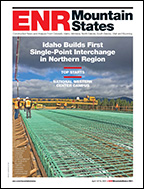Truss chords are made from 65-ksi, wide-flange beams. "The mills in the states don't make grade-65 wide flanges, so we ordered them from a mill in Luxembourg," says Chet McPhatter, chief operating officer for the steel fabricator, Banker Steel. For the heavy plate girders, there wasn't enough U.S. mill capacity available at the time, so Banker ordered them from a mill in Germany.
"It's a one-of-a-kind job," adds McPhatter, thanks to the size and weight of the pieces and the amount of shop work required, which included thick splices.
Banker created 2D shop drawings using TT's connected 3D structural model, which expedited the detailing, says McPhatter. To speed fabrication, Banker used an electroslag welder, which cuts splice time to 45 minutes from 12 hours.
Banker first came aboard in a design-assist capacity to work out fabrication and erection issues. "It's been a good team process, but there is absolutely a learning curve on this job," says McPhatter.
To save time, TP has scheduled concurrent operations, including two or three separate caisson crews and two steel erection crews. For Catik, the biggest challenge is drilling the caissons, especially as crews have to deal with so many obstructions.
To minimize surprises during drilling, before platform construction began in March of last year, TP spent eight months manually digging 6 to 10 ft at each of the 300 caisson locations. TP found about 250 obstructions—many of which were expected. Where possible, TT shifted column locations on the drawings. Otherwise, utilities were offset around caissons.
Based on track outages, TP divided foundation work—80% complete—into 11 primary zones. Construction started in the southeast corner and expanded north and west before moving to the throat.
Each caisson typically takes two hours. Rather than waste precious time switching bits, TP used two drill rigs for many of the caissons—one to excavate earth and the other rock. "We flooded the place with five or six drill rigs that we gathered from across the country," says Catik.
During off-peak train times, to gain access to what they call "the island" in the center of the site, crews laid down a north-south temporary timber road over the tracks. The LIRR required a rehearsal to show that the road and equipment setup could be done in 45 minutes and the retreat in 45 minutes to an hour—in case the LIRR needed the tracks cleared quickly.
TP is constructing the platform itself in phases, again developed to reflect LIRR track outages. Once a deck is installed in an area, it provides protection for the trains and tracks below as well as a staging area for the next phase. Equipment currently comes in through an elevated construction road off the elevated 11th Avenue, on the west side of the site.
For the big truss picks, TP is using a 660-ton tower crane with a 220-ft reach that moves on crane rails on the platform deck. The tower crane had to be reserved nine months in advance.
In one area, running north-south and standing 30 ft apart, seven pairs of 12-ft-deep trusses span 150 ft of track. The trusses were designed as connected pairs, as opposed to one unit, to cut pick weights in half. The maximum pick is 100 tons.















Post a comment to this article
Report Abusive Comment